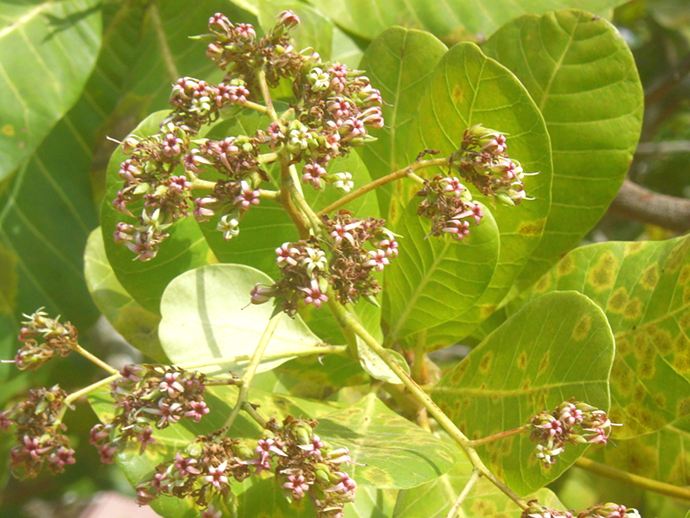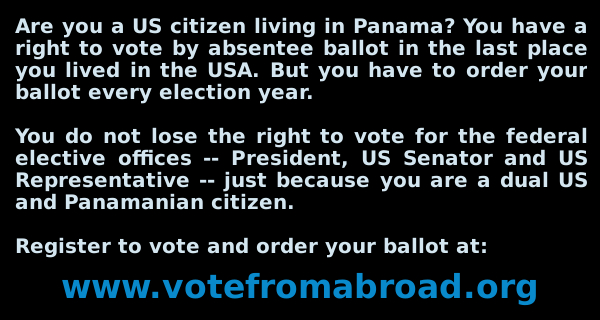Nearly a year ago, the Panama Institute of Agricultural Research (IDIAP) responded to what a lot of people on the western part of the Pacific Side — from Panama to Chiriqui provinces — had been noticing. Our cashew (marañón in Spanish) trees were sick and dying. At the time they said they thought the culprit was one of two kinds of fungus. But they didn’t identify it, and only in late September of last year did that say that they would be looking for international assistance — from Brazil. Photo by Eric Jackson, of his ailing cashew tree.
Not counting any sinister aspects,
security alarms should sound
by Eric Jackson
Does it take a history major, or someone who has looked at some of the reasons for mass migrations of our times to realize it? A most fundamental aspect of any nation’s security is the availability of food and water for its population.
The desert starts to expand, and first you have people fighting over who controls the scarcer water resources. Next you have people who can’t produce food like they used to leaving for wherever they might find and settle upon greener pastures.
A fishery depletes. Some leave for other countries, some turn to this or that maritime racket to feed themselves and their dependents, and some go to the city to look for a job.
The ancient scriptures are full of tales about great sieges where the attacking armies sought to cut off the food and water supplies. Before there were Arabs or Jews, someone found a place in the Levant with an underground river that with that time’s technology a besieging army could neither block nor poison, and that place became Jerusalem.
Is the axiom that a nation’s ability to feed itself is the cornerstone of its security seen in entirely different ways by those who grow food and those who “know” that food comes from the grocery store?
Panama has a bad economy, but apart from that its food supplies are constantly threatened by the weather, the changing ranges of pests and agricultural diseases old an new.
Two or three years ago, a lot of Panamanians noticed that their cashew trees were getting sickly.
The people with cashew trees? All sorts, really, but those whose livings depend on them are few and mostly marginalized. These trees grow well in relatively poor soil. Roasting the nuts to neutralize the toxic oil is dirty and dangerous. You will get painfully sick if you eat cashew nuts that are not thoroughly cooked. The fruit don’t have much of a shelf life, unless you dry them or make jam with them. The juice has this odd, astringent taste and texture, and will stain your clothes if you get it on you. Balancing that latter risk, jugo de marañón is an effective folk palliative for many kidney complaints and it said to improve mental function in aging heads. It’s usually mixed with other juices, often mango nectar.
Anyway, there isn’t much in the way of industrial production here. To the bankers and tax collectors’ bottom lines cashews are a negligible commodity whose commercialization happens small-scale on the informal market. But if all or part of your living comes from your land….
That might explain the lackadaisical search for which species of plague, and the lack of curiosity in the rabiblanco media.
To what can we chalk up some of the late notice that this is a problem not only here but in South America and Africa? Or that in 2016 two Tanzanian researchers, Donatha Damian Tibuhwa and Shamte Shomari of the University of Dar es Salaam, identified the problem as Fusarium oxysporum? They had help from a Japanese laboratory with the DNA work and published their findings in the Asian Journal of Plant Pathology.
So are we to conclude “silly IDIAP” or even “racist “IDIAP” and now that we know what it is, look up the cure?
Not nearly so simple. For example, just what IS Fusarium oxysporum?
By many standards, some amazing stuff. These fungi can eat gold.
But taxonomists disagree about precisely what it is. Is it a species with many strains — at least 38 that are known — or a genus with that many or more species? Or a “sub-genus?”
Whatever you want to call it, Fusarium oxysporum is found from tropical rainforests to Arctic tundras, from swamps to deserts. It gets into the soil.
However, as to the cashew blight we have here, the top leaves and branches are the first to be visibly affected, with branches drying out and withering. By all outward appearances the infection works its way down to the roots. At IDIAP they have been looking at how the pathogen — whatever they decide it is — attaches itself to cashew trees and what might be done to prevent that from happening.
Variants of Fusarium oxysporum have devastated multinational agribusinesses — the Fusarium oxysporum f. sp. lycopersici, in a double whammy with the Tobacco Mosaic Virus, has thwarted large-scale attempts at growing tomatoes for processing into paste here. Yes, there are chemicals that can be put into the soil and onto the tomato plants, but not economically so as yet. Fusarium oxysporum f. sp. cubense causes the Panama disease that may make the vulnerable Cavendish bananas go extinct, like a related strain of it did to the Gros Michel bananas many decades ago.
But couldn’t we just do the DNA analysis and at least know exactly with what we deal?
Actually, Panama’s underdeveloped labs aren’t well set up to defend us from either plant or animal plagues, and that includes human diseases as well.
But then, don’t we usually call in the Americans in such circumstances?
We do have some very good US scientists here. But we also have a US administration that sneers at the US island of Puerto Rico in a crisis and would not be likely to go far out of its way to help Panama. However, it’s worse than just that.
See, Fusarium oxysporum is also the basis for genetically engineered — in the United States — biological warfare agents. Under the original configuration of Plan Colombia, the US government required Colombia to spray a version of this fungus developed in American labs over vast stretches of our neighboring country, as part of the “Agent Green” used to eradicate coca plantations. Surely that stuff passed through Panama until its use was discontinued in 2001. Plant diseases sprayed from airplanes might expect to get into the environment, perhaps take many different routes to spread, perhaps mutate along the way. So is Uncle Sam going to want to do or fund research that might in turn embarrass the United States government for an experiment it ran on a Latin American country?
How serious a biological weapon threat is Fusarium oxysporum? Bad enough that the European Union has declared it an illegal weapon of war.
The thing is, it generally takes about three years for one of these infections to kill a cashew tree. So IDIAP may figure that although we may luck out with the sudden discovery of a cure, more likely Panamanian cashews are a goner in the likely time frame we who grow them face.
See, e.g., https://en.wikipedia.org/wiki/Fusarium_oxysporum#%22Agent_Green%22_in_Colombia if you want to think germ warfare scenarios. It would be interesting to have full disclosure.
Contact us by email at fund4thepanamanews@gmail.com
To fend off hackers, organized trolls and other online vandalism, our website comments feature is switched off. Instead, come to our Facebook page to join in the discussion.
These links are interactive — click on the boxes












